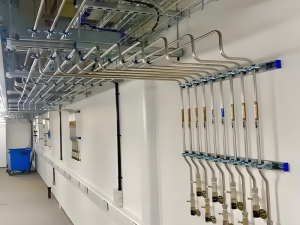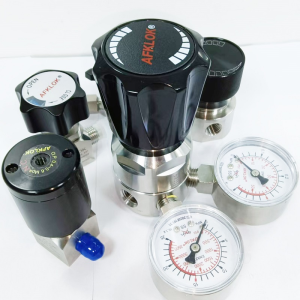目录
ToggleA gas piping system is a complex network designed to transport gases from a source to various points of usage, such as laboratories, industrial plants, and medical facilities. The system’s components must be carefully selected and installed to ensure safety, efficiency, and reliability. Here is an overview of the main components of a gas piping system:

Gas Piping System Components
- Pipes
– Conduits for transporting the gas from one point to another. They are available in various materials such as stainless steel, copper, and polyethylene depending on the gas type and pressure.
- Valves
– Control the flow of gas through the system. Types include ball valves, diaphragm valves, needle valves, and relief valves.
- Flanges
– Provide a connection point for pipes and other components. Flanges are typically bolted together and sealed with gaskets.
- Sealing Gaskets
– Used to create a tight seal between flanges, preventing gas leaks.
- Compensators
– Absorb the expansion and contraction of the pipe due to temperature changes, reducing stress on the system.
- Fasteners
– Bolts, nuts, and screws used to connect flanges and other components securely.
- Expansion Joints
– Similar to compensators, they allow for axial, lateral, or angular movement in the piping system.
- Flexible Joints
– Permit angular and axial displacement without transferring forces to the rest of the system.
- Pressure-Resistant Joints
– Special joints designed to withstand high pressures.
- Pressure-Resistant Hose
– Flexible hoses capable of withstanding high pressures and used for short connections or where flexibility is required.
- Water Evacuators
– Devices to remove condensation or water from the gas stream.
- Filters
– Remove impurities from the gas to ensure it is clean and safe for use.
- Separators
– Separate gas from liquid or solid particles.

Pipe Supports and Attachments
– Mounting Fixtures: Spreader bars, spring hangers, tilt rods, etc., to support and stabilize the pipe.
– Load-Bearing Fixtures: Saddles, bases, rollers, brackets, and sliding bearings to bear the weight of the pipe.
– Attachments: Hangers, lugs, rings, clamps, U-clamps, and more to attach the pipe to supports.
Welding Materials
-Electrodes, Wires, Fluxes, Shielding Gases
– Essential for welding pipe sections together and ensuring a strong, leak-proof connection.
Inspection and Testing
– Quality Assurance: Components must have quality certificates and safety marks if required.
-Inspection and Testing: Regular checks to ensure components meet safety and performance standards.
Gas Type and Pressure
-Different gases have varying properties (e.g., flammability, toxicity) that necessitate specific piping materials and safety measures.
-High-pressure systems require robust materials and components to withstand the force.
Installation and Testing
-Proper Installation: Adherence to codes and standards is crucial for safety and compliance.
-Leak Testing: Thorough testing to identify and rectify any leaks before the system is put into operation.
-Pressure Testing: To ensure the system can withstand the intended operating pressure.
In summary, the components of a gas piping system must be chosen carefully based on the specific requirements of the application. Regular maintenance and adherence to safety protocols are essential to ensure the system functions optimally and safely over its lifespan.
0